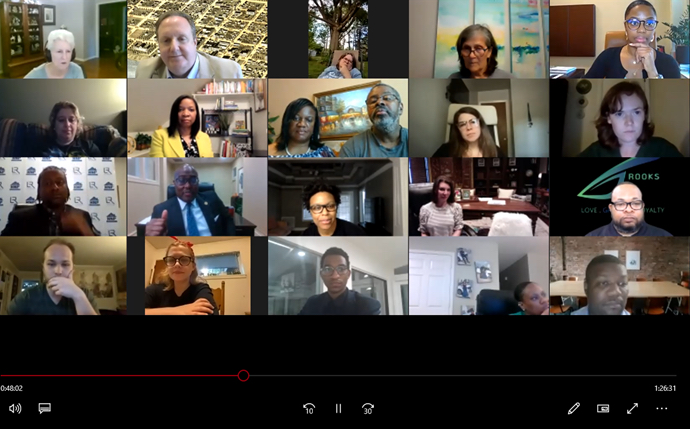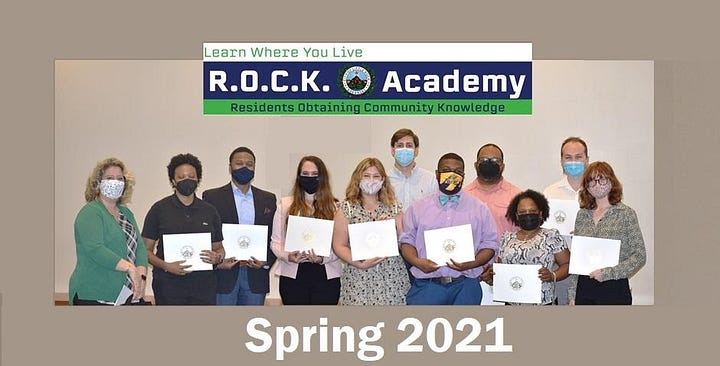Little Rock, Arkansas, USA
Little Rock Shows How Open Data Drives Resident Engagement.
Project Type:
Community Engagement, High-Performing Government, Infrastructure, Public Safety

This narrative was written for Little Rock’s 2021 Silver What Works Cities Certification. The City most recently re-Certified at Silver in 2024. Some content may be outdated. For the most current information, please visit www.littlerock.gov.
At a Glance
Used data to determine and understand the needs of neighborhoods with higher crime rates.
Lights on Little Rock, a streetlight canvassing project, engaged residents across 163 neighborhoods in the process of using data to improve their city.
Launched R.O.C.K academy, a data-analytic program designed to catalyze civic engagement by showing people how city government works.
Little Rock’s Commitment to Public Safety
The 12th Street corridor is in the heart of Little Rock, stretching west from downtown across multiple neighborhoods. But for years the area had suffered from high crime rates and disinvestment, and is considered a food desert.
With the intention of improving public safety and supporting efforts to revitalize the area, the City built a new police station in 2014 on the street. And, in the years following, as city staff ramped up efforts to place data at the center of problem-solving, it began to hold two-day-long “Data Academy” training sessions for city employees and residents on foundational data practices, including data analysis.
Responding to public safety concerns, a 2018 Data Academy training focused on 12th Street. A cross-department team dug into data sets to understand the challenges facing the area, looking at variables including crime, building code violations, and poverty. It turned out the neighborhood with the highest levels of crime and blight was actually blocks away from 12th Street itself, in Midtown. A predominantly African-American neighborhood just east of the University of Arkansas at Little Rock campus, Midtown has a mix of older longtime homeowners and younger renters.
“It was a real data-driven ‘a-ha’ moment — an example of what you can understand about a city if you have the right data sets and look in the right places,”
311 Data and Neighborhood Safety
Newly aware of Midtown’s challenges, city officials decided to engage residents in the neighborhood and adjacent areas. Data Academy members hosted a human-centered design workshop, during which residents were given the opportunity to self-prioritize their pressing concerns. Rather than lead the workshop, officials from various city departments quietly observed the discussion.
The main issue that emerged? Many parts of Midtown were poorly lit due to broken or blocked streetlights. Many residents didn’t feel safe and didn’t know how to alert the City to get lights fixed or vegetation cut back. A review of 311 request data showed that few streetlight problems in the area were ever reported to the City.
Aware of studies showing the correlation between dark streets and crime, the City designed a streetlight canvassing project in partnership with area neighborhood associations to engage and empower residents. Bridges and her team built canvassing route maps using Google Maps and Little Rock Citizen Connect, which collects 311 requests and other data sets. Then they gathered resident volunteers to walk or drive Midtown’s streets on a Friday night, using the City’s 311 mobile app to make a light service request and tag the location.
“The impact was immediately clear in the 311 data,” Bridges says. Thirty-seven streetlight-related requests were submitted in one night, compared to a total of 15 service requests made via the 311 system in Midtown during the previous 10 months. The City replicated the effort in another neighborhood with similar success, using 311 data to facilitate light repairs by the power company.
The next step: a citywide campaign involving all 163 neighborhood associations called Lights on Little Rock, which launched in February 2019. Bridges created and distributed a four-page report detailing the canvassing and 311 reporting process. Word got around and success followed success. A group of college fraternity members fulfilled their community service requirements by canvassing an entire community in one night. One resident recounted at a town hall meeting how she and her child turned streetlight canvassing into a game.
“The campaign has given residents a real sense of accomplishment. But it’s about more than just streetlights and the quality of life in our neighborhoods. This success has served to push our resident engagement and education efforts around data to the next level across the City.”
Knowledge = Empowerment
The Lights On campaign inspired Mayor Scott to look for ways to further improve the City’s relationship with residents. One result was R.O.C.K. Academy, launched in fall 2020 after a pandemic-related delay; the acronym stands for Residents Obtaining Community Knowledge. Run out of the Mayor’s Office, its purpose is to catalyze civic engagement by showing people how city government works.

The Academy’s first session offers an overview of city government, including how Little Rock’s commitment to data transparency empowers residents. “Data is one of the very first topics we tackle in the Academy,” says Bridges, noting that in 2016 Little Rock became the first municipality in Arkansas to launch an open data portal. “Residents learn about our open data policy and portal, and how we build tools to help residents understand and engage with the government.”
Bridges proposed the Academy to the mayor’s office, and in many ways it is the culmination of the City’s years-long commitment to open data practices and cultivating a data-driven performance culture. Bridges had been developing the Academy’s programming for years, in part through city events and training to teach residents how to use tools on its Data Hub and Little Rock Performance. The latter is a centralized dashboard that covers six priority areas and offers in-depth performance data via visualizations, maps, charts, and graphs.

The classes came out of Bridges’ work in various neighborhoods fielding ad hoc requests for data. “I realized that many residents didn’t understand how the City functioned — they didn’t know who to call for what,” Bridges says. The Academy is changing that. As of July 2021, 49 Little Rock residents have graduated; the plan is to hold two sessions annually.
Little Rock’s capacity to engage residents and use data to support decisions and programs has grown immensely over the last decade, says Mary-Julia Hill, who has been president of the Briarwood Area Neighborhood Association since 2012. Years ago, she would sift through pages and pages of crime data spreadsheets and city reports to help her neighbors understand local trends. Now she uses Citizen Connect and teaches fellow city residents to do the same. Anyone can search the open data resource by data range and item type, including crime incidents, 311 requests and planning permits; the site shows trends for selected criteria and time durations.

“Little Rock’s data infrastructure and transparency has evolved dramatically, and it’s been amazing to watch how that has translated into broader and deeper civic engagement.”
Bridges agrees, noting that Little Rock’s data-related capacities have grown “exponentially” over recent years.
“The sense of security and empowerment residents feel in knowing how to find and engage with the data they seek — it simply cannot be overstated. That’s a key part of Little Rock’s data-driven future.”